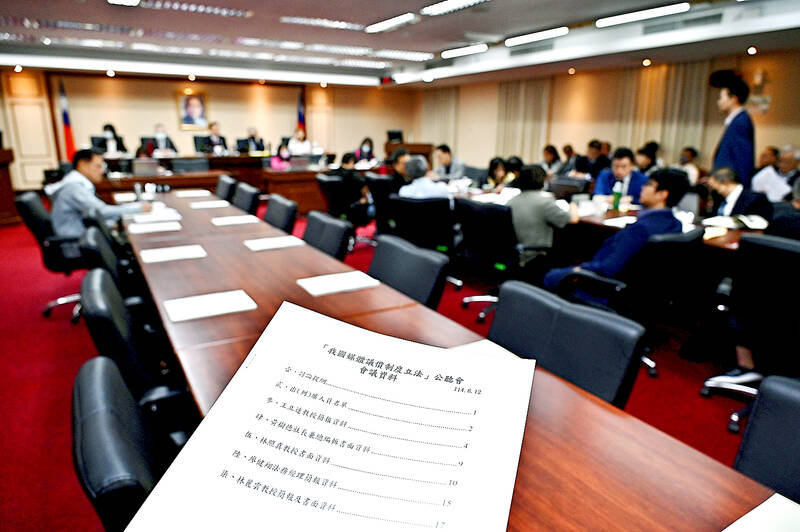Lawmakers could pass a draft act this legislative session that would require Google, Meta and other social media companies to negotiate with Taiwanese media companies over a fair share of advertising revenue generated through the publication of online content.
The legislature’s Transportation Committee yesterday held a public hearing on a “news media and digital platform bargaining draft act,” in which government officials and representatives of academia, journalist associations and media associations talked about the issue.
The Chinese Nationalist Party (KMT), the Democratic Progressive Party and Taiwan’s People Party (TPP) have proposed their versions of the act, while the Ministry of Digital Affairs last month said it would also present its version of the bill before the end of the year.

Photo: Tu Chien-jung, Taipei Times
However, Minister of Digital Affairs Huang Yen-nun (黃彥男) has said that passing such a bill could be seen by the US as a trade barrier and trigger a trade response.
The ministry had pledged in a written report to facilitate communications between news organizations and digital platforms. Similar pledges were made in reports by the National Communications Commission, Fair Trade Commission and the Ministry of Culture.
KMT Legislator Wang Hung-wei (王鴻薇) and TPP Legislator Chang Chi-kai (張啟楷) said that if the digital ministry is concerned about retaliation from the US, the government could make the first move by mandating that platforms negotiate with news media over the pricing of news content.
TPP Legislator Lin Kuo-cheng (林國成), who presided over the hearing, urged the ministry to quickly propose its version of the act, as the legislature would not wait for it to start deliberating a draft act.
“A review would begin once lawmakers reach a consensus on the matter, and after that, the bill would be put to a final vote in the plenary session,” Lin said.
Some who spoke at the hearing supported establishing a mechanism for news media to bargain with large digital platforms while others advocated for a dual-track system, in which large media groups could negotiate directly with online platforms on content pricing, and smaller entities could accept financial support from a fund jointly set up by the digital platforms and the government.
Reactions were mixed as to whether the draft act should address concerns raised by the increased use of artificial intelligence (AI).
Some said AI services should pay news media for using their content to train their models, while others warned that such measures could compel service operators to use free sources to train their systems instead.
Others said that the problem should be addressed after the act is passed.
Taipei Newspapers Association chairman Huang Shu-de (黃樹德), who is also the managing editor of the China Times, said that the draft act should focus on a mandatory bargaining and establishing an arbitration system for news companies and digital platforms.
If a fund is to be set up to support news organizations, the bill must ensure that donations from the government and platform operators are mandatory, Huang said.
Such a fund should be appropriated based on the size of the media companies and their operating costs, among other criteria, he said.
The rules of appropriation should be stipulated by the four major media associations: the Taipei Newspapers Association, the Media Business Association of Taipei, the Association of Terrestrial Television Networks and the Satellite Television Broadcasting Association (STBA), he said.
United Daily News legal department manager Liao Chien-hsiang (廖健翔) said that the Taipei Newspapers Association has worked with the STBA on procedures of arbitration for the draft act.
“We suggest that the Fair Trade Commission enforce the draft act,” which is similar to Australia’s News Media and Digital Platforms Mandatory Bargaining Code, Liao said.
Digital platforms would be obligated to report to their agents in Taiwan, who would be responsible for providing information during bargaining and arbitration, such as the algorithms they use to display the content and their aggregate digital service revenue, he said.
Huang Chiu-hsuan (黃秋璇), a legal specialist at the Liberty Times (the Taipei Times’ sister newspaper), said that the newspaper agreed with the statements from other newspapers, but added that the digital ministry should address problems caused by AI-generated news content.
Taiwan’s digital advertising market surged to NT$61 billion (US$2.1 billion) in 2023 from NT$11.6 billion in 2012, a petition launched yesterday to support the bill said, citing Taipei Media Agency Association data.
In contrast, traditional media advertising plummeted to NT$21 billion from NT$42.5 billion during the same period, with the total value of digital advertising now nearly three times that of traditional media advertising, it said.
As media content is appropriated by digital platforms and traditional advertising revenues plummet, news organizations are forced to slash budgets, leading to lower salaries and heavier workloads for journalists and media personnel, and a decline in reporting quality, it said.
Journalism students and newcomers to the industry face an uncertain future, it said.
“This is not merely a crisis for the news industry, it is a systemic threat to the public’s right to know and a fundamental erosion of democracy,” it added.
The petition was endorsed by professors and researchers from journalism and communication schools around the country, 22 news media professionals, 14 media organizations and 15 journalism student organizations.

A strong continental cold air mass is to bring pollutants to Taiwan from tomorrow, the Ministry of Environment said today, as it issued an “orange” air quality alert for most of the country. All of Taiwan except for Hualien and Taitung counties is to be under an “orange” air quality alert tomorrow, indicating air quality that is unhealthy for sensitive groups. In China, areas from Shandong to Shanghai have been enveloped in haze since Saturday, the ministry said in a news release. Yesterday, hourly concentrations of PM2.5 in these areas ranged from 65 to 160 micrograms per cubic meter (mg/m³), and pollutants were

Taiwan’s armed forces have established response protocols for a wide range of sudden contingencies, including the “Wan Chun Plan” to protect the head of state, the Ministry of Defense (MND) said today. After US President Donald Trump on Saturday launched a series of airstrikes in Venezuela and kidnapped Venezuelan President Nicolas Maduro, concerns have been raised as to whether China would launch a similar “decapitation strike” on Taiwan. The armed forces regularly coordinate with relevant agencies and practice drills to ensure preparedness for a wide range of scenarios, Vice Minister of National Defense Hsu Szu-chien (徐斯儉) told reporters before a

EVA Airways on Saturday said that it had suspended a pilot and opened an investigation after he allegedly lost his temper and punched the first officer several times as their plane was taxiing before takeoff at Los Angeles International Airport. According to a report published on Thursday by The Reporter, the incident occurred after the flight’s Malaysian first officer tried to warn the Taiwanese pilot, surnamed Wen (文), that he was taxiing faster than the speed limit of 30 knots (55.6kph). After alerting the pilot several times without response, the first officer manually applied the brakes in accordance with standard operating

The New Taipei City Social Welfare Department on Thursday celebrated Paralympic competitor Chen Tzu-wei (張孜維), who received last year’s national Golden Eagle award for exemplary achievement by Taiwanese with disabilities. Chen, who suffers from childhood-onset muscular dystrophy, did not attend the first award ceremony held by the Ministry of Health and Welfare in November due to illness. Chen was formally presented with the award at the department, where he gave thanks to government workers for supporting his education and livelihood, the department said in a statement. Chen was raised by the Ai-hsin Home for Persons with Disabilities in the city’s Bali District (八里)